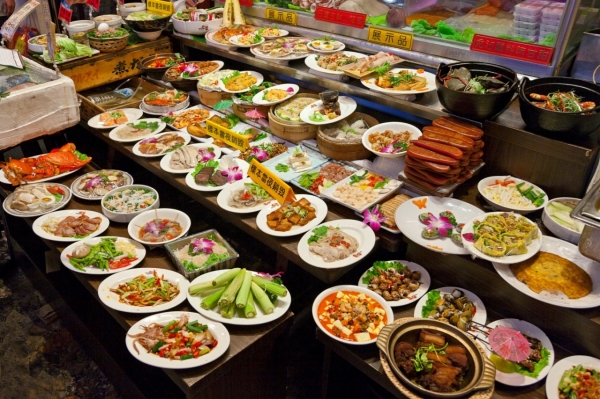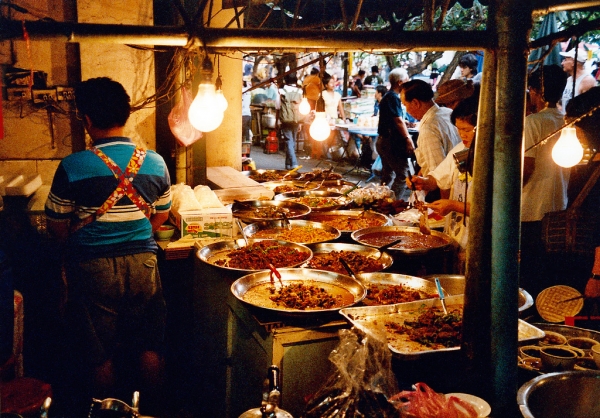Don't miss out on the best jobs!
Subscribe to HelpGoAbroad and weekly we will sent you an email with latest job posts. Provide your email address below
One of the best parts about traveling overseas is being able to sample the local dishes of each place that you visit. While some opt to go to fancy restaurants and fine dining in order to taste the best of the best, many others choose to hit the streets for cheap and delicious meals. Street food is fast, fresh (hopefully), and a great way to see how locals eat. You can find street stalls everywhere, such as at markets with rows of competing hawkers, schools where vendors wait for students to mob them for snacks, and especially in bar districts full of unsteady patrons. You will find them around temples, on loud and quiet streets, and there are some cities where you will not be able to walk two feet without running into a mobile street stall.
You will find mouthwatering sweets, salty treats, and everything in between. While you do want to give your mouth the time of its life, you do NOT want to give your stomach a reason to rebel with a ticket to the toilet. While every responsible traveler should have a stash of antibiotics and tummy soothers, here are some tips to save your health, and dignity, from food poisoning and other foodborne illnesses.
1. Check Online/Travel Warnings
Before visiting a new destination and diving headfirst into the local nosh, you should definitely look online for any travel warnings about potential illnesses that you might encounter. Whether you look at government websites or the blogs of fellow travelers, it is always good to know what you might encounter. If you see people saying anything along the lines of, “Delhi Belly”, “Turkey Trots”, or “Montezuma’s Revenge”, you might want to be extra cautious about what you eat. Also look into the types of bacteria that you are most likely to come in contact with, especially if there are any strains that are immune to certain antibiotics.
2. Ease Your Stomach In
One of the rookie mistakes that people make are to immediately throw themselves into the sea of street stalls and local food. Vendors are everywhere so it seems so convenient that you probably equate these stalls with fast food (this must be the Thai McDonalds!). Do not make this mistake. If you are not a seasoned traveler, then you likely have not been exposed to a variety of bacteria. Contrary to popular belief, there are some types of good bacteria which will help you in the battle against the invading foreign stuff. Ease your stomach in by eating local food from reputable restaurants in order to give your stomach time to assimilate to the new types of food. Stay away from anything too spicy or too different from your usual diet until you have had a day or two to adjust.
3. Crowds
Once you are ready to tackle street stalls head on, it is time to teach you how to recognize the good ones. Not all street stalls and vendors are made equal and the best way to weed the worst (read: guaranteed sickness) from the best (mind-blowingly awesome) is to see who has attracted the crowds. If there are hordes of locals or even a bunch of foreigners who look in-the-know that are flocking to one stall, then get yourself in line. You are less likely to get sick and much more likely to experience a great meal.
4. Cooked Food
While this is not a foolproof method, one way to avoid sickness is to stick to cooked food. If the meal has been heated properly and to the correct temperature, any potential bacteria will be destroyed. This means staying away from salads and other raw dishes, but until you get a handle on how your body will react, better safe than sorry.
5. Deep Fried Food
If you take the cooked food approach as a way to sidestep “Delhi belly”, then choosing deep fried food is surely an even more effective decision. Food is heated to such a high temperature that anything harmful will probably get seared away. In my mind, it is the equivalent of exposing disease vectors to the surface of the sun.
6. Fresh Food
Regardless if you are eating raw food or cooked dishes, you should always make sure that the vendor is using fresh ingredients. You do not want something that has been sitting around since the dawn of time, and then some. Check for stinky smells or anything overpowering that might suggest the food is rotten. If it is durian, do not worry, the fruit is supposed to smell pungently.
7. Water or Ice
Most places that I visit for the first time do not include any addition of tap water or ice. Tap water is avoided since it carries a freakishly high number of possible diseases and viruses if not properly treated and ice because, well, where do you think they make the ice from? If a place has safe tap water, then go for a glass with some ice. If you are guaranteed bottled or boiled water to be used for ice, then you can enjoy a cool beverage along with your street food without fear of illness.
8. Rice
This came as a surprise for me. What, in my mind, could be safer from bacteria than rice? It is boiled and cooked. Nothing could go wrong. Actually, it turns out that rice is a transmitter for disease when it has been sitting around all day. This happens a lot since such a large amount is made that there are portions that do not get used up for hours, leaving plenty of time for little beasties to start growing and preparing to invade your stomach. Always make sure that the rice is fresh or that only a small amount is made at one time.
9. Clean Chopping and Cooking Utensils
You can emerge unscathed by foodborne illness even in the event of raw food as long as the utensils used by the vendor are clean. That means that they need to wash their hands with soap and make sure that their knives are properly cared for. Anything that is used to prepare your food needs to have been properly washed so that there is nothing on them to spread to the food and then onto you.
10. Quick Turnover
Similar to number 3, look for a place with a high turnover rate. While it would be optimal to find a vendor that cooks each meal on the spot, there are some street stalls that just lay the food out since it has already been cooked. If this is the case, definitely make sure that the food is disappearing fast and that the vendors are continually putting out freshly made dishes to replenish what has already been demolished.
Sign in to publish a comment



Be the first to comment on this post.